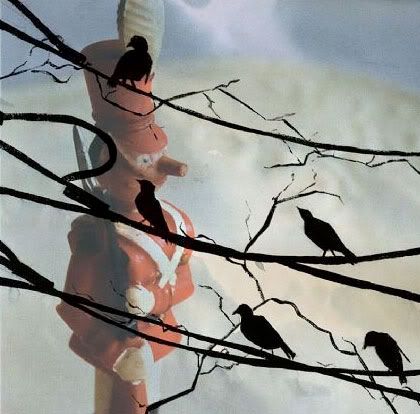
The Story of Vasco
Orange Tree Theatre, Richmond
Unnerving and absurd, but strangely touching, The Story of Vasco is about as odd and unlikely as the circumstances of its recent discovery. Initially intended to form the libretto for an opera by Gordon Crosse, Hughes’ original text was put to one side after it was used only in part in the 1974 ENO production. Learning of this story, director Adam Barnard searched Hughes’ archives at Emory University, and found what was to become this mystical, earthy play.
Vasco teases its audience with the premise that idiocy can sometimes be the best way to outwit others. We suspend our disbelief and plunge all our faith into Vasco, the simple-minded barber, who is asked to complete a ‘top secret’ mission at which no one has ever succeeded.
As with much of Hughes’ work, the pervasive trickster figure of the crow dominates this production. The incessant cawing from cast members succeeds in grating on the audience's ears, while reflecting the morbid inevitability of war; ‘war must come and the crows must come’. The crow, like death, is unknowable and uncertain in his means, yet his appearance remains a certainity.
The entire production creates an otherworldly quality. The wistful peasant girl, Margeurite, played by Laura Rees, shows the beauty and wisdom of folkloric beliefs. Her ideas are able to retain their clarity whilst all around her, especially figures of authority, are tainted and scuppered. Props, too, are bizarre but effective. The placing of seven stuffed dogs on stage, reflect, with poignancy, the faith Caesar, a country man, places in the ruthless natural world.
Although the setting is generally rustic, some of the props have an unfinished quality that does not seem completely intentional. A few minor hiccups occur during the frantic costume changes, but, given that the play is only at the beginning of its run, hopefully these will be ironed out.
Other than this, the play is, on the whole, slick, and the poeticism of the dialogue is generally able to propel the slower points of the action. The complex but heavily stylised scene changes are particularly well engineered, their intricacies being almost as compelling to watch as the actual drama itself. The in-the-round arrangement of the Orange Tree means everything is seen and the choreography has to be complete even to the most minute action. A stand-out performance is presented by Michael Kirk, in the role of the Mayor a characterisation which is both elegant and sly with hints of Chitty Chitty Bang Bang's Child-Catcher.
At times it is evident that aspects of the speech have been intended as part of a libretto rather than a straightforward play, for example the frequently repeated speech of the soldiers appearing as material for a refrain. However, this does not curb the overall effectiveness of Vasco and its ability to bewilder and startle its audience with the purity that can be found in the innocence of pursuing a dream to the bitter end.
Helena S. Rampley





No comments:
Post a Comment